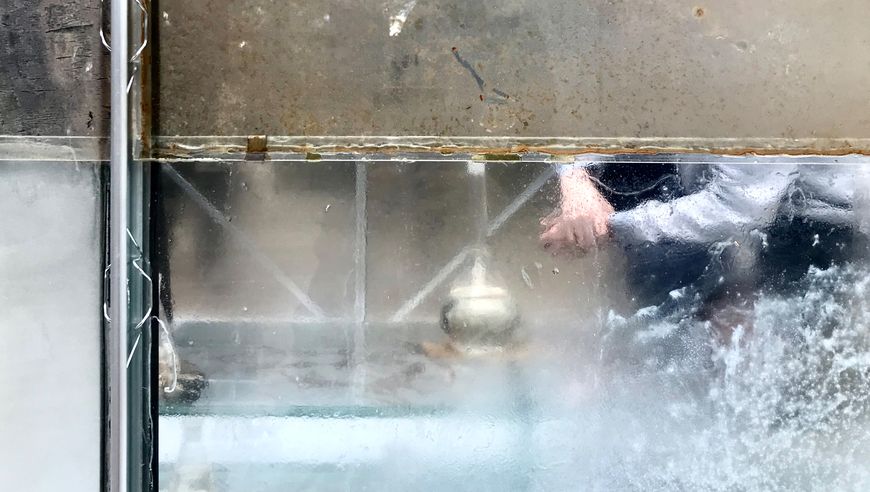Students of the seminar "New Forms of Research – Artists in Dialoge with Sciences" by Prof. Nina Fischer and Christina Landbrecht report in a few articles about their experiences:
OCEAN DWELLERS – Meeresbewohner is an exhibition curated by Solvej Helweg Ovesen, locates at Nordic Embassies, Berlin. Eleven art pieces are placed from the lobby, auditorium, and all the way up to the outdoor terrace. The exhibition has the theme of the ocean, and is from perspectives of human, with a subtitle as ART, SCIENCE AND SCIENCE FICTION.
‘Every artist who is an artist asks themselves the question of what an adequate artistic language for today might be. … What needs attending to, with what kinds of alertness? ’ Living in 2019, when we talk about ocean and nature, we no longer discuss just about its atheistic spirits, what we are facing are the in-negligible environmental issues. In this era, we long for changes. When we look we don’t just play the roles of bystanders, we also project ourselves into this contemporary issue, hoping for a glimmer of hope. The combination of art and science brings audiences artistic experience, while giving them hints of reality. In this exhibition, science fiction is cleverly used as an enchanting method. Environmental issues are no longer rigid figures and graphs, nor are they unrealistic fables. Here I chose three works from the exhibition to delineate.
Through the Bones; Listening with Carp is an audio piece by Jana Winderen presented in the auditorium. She uses recordings made from beneath the ice in the Arctic oceans around the North Pole to the tropical oceans around the Equator. There were not much literal explanation showed. In the low-lighted environment, without much visual interference, I immersed in the undersea world created by the artist. My ears were trying to search for recognisable clues, while confronting unfamiliar micro sounds. They reveal the inaudible sound to human. I was led to the world from the artist while building my own understanding by listening. Going up the stairs, you will find a few small black devices integrated into the handrails on first floor. They are devices of scent work beyond SE(A)nse by Sissel Tolaas. With the background of chemistry and art, she collects smell molecules worldwide, and creates smellscapes elsewhere. Three smells presented in this exhibition, I experienced first two of ocean water and marine life. Oder is often consider of strong connection with memory. With the watery image of ocean in mind I came to the third one, I surprisingly found the strange smell pungent and unbearable. With nothing comparable in my memory, it was collected from ocean pollutants. Seeing every visitor frowned after smelling it, no matter what the intention of the artist is, it surely drags us back to the reality of environmental problems.
Outdoor on the terrace there is the piece Veden väelle (Which means “For the Water Sprites” in Finnish.) by Elsa Salonen. It is a little glass house, the colours of the walls are composed from algae, aquatic plants, and other materials collected from the Finnish Baltic Sea and its shores. After entering, accompanied by the smell of the ocean, there are some specimen-like ocean materials displayed in the centre. This piece is based on the Finnish traditional mythology, recreated in the city of Berlin. As a temple for the water sprites, as well like a laboratory of sea to me.
Being an artist, perhaps like many others, I often ask myself: what is the reality that I am pursuing while practicing? Is it what we see, hear or smell? What is the relation of art with other kinds of knowledge? When I am in the role of an audience, I also tend to search for clues regarding my prior knowledge. However, there are things that are beyond our experience, perhaps invisible nor inaudible. Although the senses are the source of knowledge, they do not represent all knowledge. Therefore, the identity of science seems to be able to effectively expand the world we cannot reach. With the combination of art and science, text become a communication tool. It is to some extent important to share the knowledge, but at the same time, it can act the supportive role behind art works, and let the work construct an independent image in the personal world of the audience.
In OCEAN DWELLERS – Meeresbewohner, eleven groups of artists use their own individual methods and languages to communicate to the world. What the artists present to the audience may be the display of research results or by-products of researches. Once the work is put out, it can be regarded as an individual for the audience to experience. As an audience, it seems that there is no need to keep a close eye on the text. The author has the right to make decision, and the audience also has the freedom to interpret. If we treat each piece of work as a single event, we are free to experience exception stories that are beyond our daily lives.
- Yun-Chu Liang

